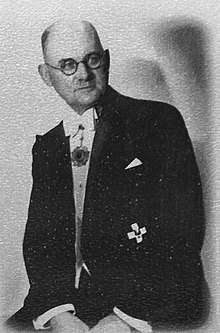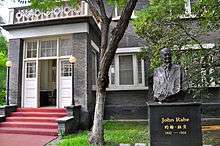John Rabe
John Heinrich Detlef Rabe (23 November 1882 – 5 January 1950) was a German businessman and Nazi Party member who is best known for his efforts to stop the atrocities of the Japanese army during the Nanking occupation and his work to protect and help the Chinese civilians during the event. The Nanking Safety Zone, which he helped to establish, sheltered approximately 200,000 Chinese people from slaughter during the massacre. He officially represented Germany and acted as senior chief of the European–U.S. establishment that remained in Nanking (now Nanjing), the Chinese capital at the time, when the city fell to the Japanese troops.
John Rabe | |
|---|---|
 | |
| Born | 23 November 1882 |
| Died | 5 January 1950 (aged 67) |
| Nationality | German |
| Occupation | Businessman |
| Employer | Siemens AG |
| Known for | Saving about 200,000 Chinese civilians during the Nanking Massacre Establishing the Nanking Safety Zone |
| Political party | National Socialist German Workers' |
| Spouse(s) | Dora Rabe |
| Relatives | Grandfather of Dr. Thomas Rabe |
Early life and career
Born in Hamburg on 23 November 1882, Rabe pursued a career in business and went to Africa for several years. In 1908 he left for China, and between 1910 and 1938, he worked for the Siemens AG China Corporation in Mukden, Peking, Tientsin, Shanghai and later Nanjing.[1] Rabe suffered from diabetes by the time he was working in Nanking, which required him to have his regular dose of insulin.[2] At the time of the Japanese attack on Nanking, Rabe was a staunch Nazi and the party's local head, as a Deputy Group Leader in the Nazi Party.[3]
Establishment of the Nanjing Safety Zone

Many Westerners were living in the Chinese capital city of the time as Nanking was, until December 1937, conducting trade or on missionary trips. As the Japanese army approached Nanking and initiated bombing raids on the city, all but 22 foreigners fled the city, with 15 American and European missionaries and businessmen forming part of the remaining group.[4] On 22 November 1937, as the Japanese Army advanced on Nanking, Rabe, along with other foreign nationals, organized the International Committee for the Nanking Safety Zone and created the Nanking Safety Zone to provide Chinese refugees with food and shelter from the impending Japanese slaughter. He explained his reasons thus: "…there is a question of morality here… I cannot bring myself for now to betray the trust these people have put in me, and it is touching to see how they believe in me."[5] The zones were located in all of the foreign embassies and at Nanking University.
The International Committee was inspired by the establishment in November of a neutral zone in Shanghai, which protected 450,000 civilians.[3]
Rabe was elected as its leader, in part because of his status as a member of the Nazi party and the existence of the German–Japanese bilateral Anti-Comintern Pact. This committee established the Nanking Safety Zone in the western quarter of the city. The Japanese government had agreed not to attack parts of the city that did not contain Chinese military forces, and the members of the International Committee for the Nanking Safety Zone attempted to persuade the Chinese government to move all their troops out of the area. They were partly successful.
On 1 December 1937, Nanjing Mayor Ma Chao-chun ordered all Chinese citizens remaining in Nanking to move into the Safety Zone and then fled the city. By the fall of Nanjing on 13 December 1937, 500,000 non-combatants remained in the city.[3]
Rabe also opened up his properties to help 650 more refugees.
Nanking Massacre
According to Rabe, the Nanking Massacre resulted in the deaths of 50,000 to 60,000 civilians. Rabe and his zone administrators tried frantically to stop the atrocities. Modern estimates vary, but some put the number of murdered civilians as high as 300,000.[6][7] Rabe's attempts to appeal to the Japanese by using his Nazi Party membership credentials only delayed them; but that delay allowed hundreds of thousands of refugees to escape. The documentary Nanking credited him for saving the lives of 250,000 Chinese civilians. Other sources suggest that Rabe rescued between 200,000 and 250,000 Chinese people.[8] In his diary Rabe documented Japanese atrocities committed during the assault upon and occupation of the city.[9]
John Rabe gave a series of lectures in Germany after he came back to Berlin on 15 April 1938, in which he said, "We Europeans put the number [of civilian casualties] at about 50,000 to 60,000."[10] Rabe was not the only figure to record the Japanese atrocity. By December 1937, after the defeat of the Chinese soldiers, the Japanese soldiers would often go house-to-house in Nanking, shooting any civilians they encountered. Evidence of these violent acts come from diaries kept by some Japanese soldiers and by Japanese journalists who were appalled by what was transpiring.[11]
Return to Germany
On 28 February 1938, Rabe left Nanking. He first traveled to Shanghai and then back to Germany. He took with him a large number of source materials documenting the atrocities committed by the Japanese in Nanking.[12]
Rabe showed films and photographs of Japanese atrocities in lecture presentations in Berlin and wrote to Hitler to use his influence to persuade the Japanese to stop any further inhumane violence. As a result, Rabe was detained and interrogated by the Gestapo and his letter was never delivered to Hitler.[13] Due to the intervention of Siemens AG, Rabe was released. He was allowed to keep evidence of the massacre, excluding the film, but was not allowed to lecture again or write on the subject.[13] Rabe continued working for Siemens, which posted him briefly to the safety of Siemens AG of Afghanistan. Rabe subsequently worked in the Berlin headquarters of the company until the end of the war.
Postwar
After the war, Rabe was arrested first by the Soviet NKVD and then by the British Army. Both, however, let him go after intense interrogation. He worked sporadically for Siemens, earning very little. He was later denounced for his Nazi Party membership by an acquaintance. He was stripped of the work permit that he had previously been given by the British Zone, and had to undergo a very lengthy de-nazification process (his first attempt was rejected and he had to appeal) in the hope of regaining the permission to work. He had to pay his own legal defense costs, which depleted his savings.[14]
Unable to work to support his family and with the savings spent the family survived in a one-room apartment by selling his Chinese art collection, but this did not provide enough to avoid malnutrition. He was formally declared "de-Nazified" by the British on 3 June 1946 but thereafter continued to live in poverty. The family lived on wild seeds that the children would eat with soup and on dry bread until that was no longer available either.[14]
In 1948, the citizens of Nanking learned of the very dire situation of the Rabe family in occupied Germany and they quickly raised a very large sum of money, equivalent to $2,000 USD ($21,000 in 2020). The city mayor himself went to Germany, via Switzerland where he bought a large amount of food for the Rabe family. From mid-1948 until the communist takeover the people of Nanking also sent a food package each month, for which Rabe wrote many letters expressing deep gratitude.[14]
Death and legacy

On 5 January 1950, Rabe died of a stroke. In 1997 his tombstone was moved from Berlin to Nanjing (as it is now) where it received a place of honor at the massacre memorial site.
In 2005, Rabe's former residence in Nanking (as it then was) was renovated and now accommodates the "John Rabe and International Safety Zone Memorial Hall", which opened in 2006. The Austrian Service Abroad was invited to send a Peace Servant.
His grave in Kaiser Wilhelm Memorial Cemetery in Berlin-Charlottenburg was re-erected in 2013.
War diaries
His war-time diaries were published in English as The Good German of Nanking (UK title) or The Good Man of Nanking (US title) (original German title: Der gute Deutsche von Nanking).
Portrayals in film
John Rabe has been portrayed in numerous films:
- In Mou Tun Fei's 1995 film Black Sun: The Nanking Massacre. Minnie Vautrin and George Ashmore Fitch are also depicted.
- In Wu Ziniu's 1995 film Don't Cry, Nanking, actor Ulrich Ottenburger played Rabe, although his name was changed to "John Robbins."
- In Bill Guttentag and Dan Sturman's 2007 documentary film Nanking, actor Jürgen Prochnow played Rabe.
- In Lu Chuan's 2009 film City of Life and Death, actor John Paisley played Rabe.
- In Florian Gallenberger's film John Rabe, also released in 2009, Ulrich Tukur played John Rabe.[15]
See also
- Robert Jacquinot de Besange, a French Jesuit who saved more than half a million Chinese civilians.
- Minnie Vautrin, an American missionary who saved thousands of lives during the Nanking Massacre.
- Robert O. Wilson, an American physician who treated victims brought to the Nanking Safety Zone.
- John Magee, an American priest and missionary who documented the Nanking Massacre.
- Bernhard Arp Sindberg, a Danish workman who saved thousands by harbouring them in a factory during the Nanking Massacre.
- Georg Rosen, consular employee of the German Foreign Office who helped create the Nanking Safety Zone.
References
- John Rabe Homepage: Curriculum Vitae Archived 10 June 2009 at the Wayback Machine
- John Rabe, Erwin Wickert (1998). The Good Man of Nanjing: the Diaries of John Rabe. A.A. Knopf. p. 254.
- Dunning, Brian. "Skeptoid #480: The Nazi of Nanking". Skeptoid. Retrieved 29 April 2017.
- Bennett, Ralph Kinney (October 1998), "They Will Not Be Forgotten", Reader's Digest, p. 53.
- Rabe, John, "Letter to Hitler", Rabe's diary, archived from the original on 23 April 2012
- Slavomir Zidarov: John Rabe und seine Tagebücher in der gegenwärtigen Debatte um das Nanjing-Massaker, 2013
- Ruth Hallo: John Rabe und seine Rezeption in China (Berichte aus der Geschichtswissenschaft), Shaker Verlag, Herzogenrath 2002
- John Rabe Archived 22 July 2013 at the Wayback Machine, moreorless
- Woods, John E. (1998). The Good Man of Nanjing: the Diaries of John Rabe. p. 67.
- Japan Echo Inc (2007). "Japan echo". 34 (1–6). Cite journal requires
|journal=(help) - Donald G. Dutton (2007). The psychology of genocide, massacres, and extreme violence: why "normal" people come to commit atrocities. Greenwood Publishing Group. pp. 64–65.
- "Biography". John Rabe's Nanjing Diaries. Retrieved 29 July 2019.
- "Shelter Under The Swastika: The John Rabe Story". NPR. 14 June 2010.
- Chang, Iris, The rape of Nanking: the forgotten holocaust of World War II, pp. 191–94.
- Cineuropa: news 27 April 2009: Awards – Germany
Sources
- Erwin Wickert (editor). (1998). The Good German of Nanjing: The Diaries of John Rabe, Knopf. ISBN 0-375-40211-X
- Original German: (1997). John Rabe. Der gute Deutsche von Nanking. Deutsche Verlags-Anstalt, Stuttgart. ISBN 3-421-05098-8
External links
| Wikimedia Commons has media related to John Rabe. |
- John Rabe Peace and Communication Center Heidelberg (in German)
- john-rabe.com at the Wayback Machine (archive index)
- Museum Recalls Hero of 'The Rape of Nanjing' Fall 2006 NPR program about Rabe
- https://rabediaries.hypotheses.org/ Research project: John Rabe's Nanjing Diaries: Testifying and Contesting War Experiences in China and Japan